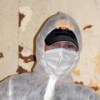Mike the Mad Biologist has some worrisome new findings on Acinetobacter, an emerging bacterial pathogen that has cropped up in the Middle East and Mexico. Mike discusses a new study on Acinetobacter genomics, showing that it has an island with 45 resistance genes, and that it's resistant to damn near everything. Just what we need--more "superbugs."
Advertisment

Sorta on-topic: NPR had a story on the long term use of antibiotics to treat acne in teens. One of the things said was that they were using low-dosing to reduce some of the side effects.
But it seems to me that low-dosing increases the risks associated with antibiotic resistance. If you're using enough to have an effect on acne, you're using enough to kill bacteria -- but by low-dosing, aren't you also lowering the resistance bar -- allowing more moderately resistant bacteria to survive than otherwise would? I figured I'd ask here, since you are the person I thought of when I heard the story.
Good question. That's long been the concern with the use of antibiotics in farm animals: they're given at sub-clinical doses to improve growth, which seems like the ideal conditions for the development of resistance. To my knowledge, that's not been rigorously tested, but I've not reviewed that area as well as I should have. Mike's an antibiotic professional, though, so you might want to hit him with that question.